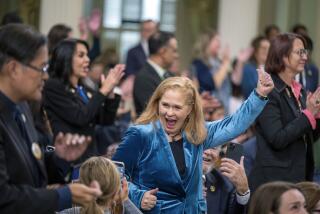Term Limits Keep Competition Alive
Critics of California’s term limits have made persuasive arguments. Because no member can stay long enough to develop genuine expertise, they say, the state Legislature suffers from unseasoned lawmakers and short institutional memory. Political turmoil is constant, for as soon as one legislative leader takes the helm, would-be successors are already elbowing to get next in line.
Instead of the citizen legislators that term-limit proponents had promised, we have ambitious politicians who see service in one chamber mainly as a path to election in the other, or to higher office.
But for all their shortcomings, we still need term limits. Without them, races for the Legislature would feature only slightly more competition than elections for the Supreme People’s Assembly of North Korea.
Consider the circumstances. In the latest round of redistricting, legislators essentially guaranteed each party a certain share of seats, locking in Democratic majorities of 50-30 in the Assembly and 26-14 in the Senate.
Democrats might have tried to extend their majorities even further, but such a maneuver would have created a number of districts where Democratic margins were fairly narrow. Instead, they consolidated their gains, redrawing boundaries to add more Democrats to their weaker districts.
For Republicans, the good news was that the remaining districts were safer for their party. The bad news was that they would have little chance of gaining any more seats. For voters, there will be no suspense in November because few if any seats will change partisan hands.
If there is going to be any competition under these district lines, it will take place not in the general election but in the party primaries. Here is where term limits are crucial, since incumbents have an overwhelming edge in primaries.
Of the 49 Assembly members who sought renomination in the 2002 primaries, 46 ran unopposed. (That figure includes Tom Harman [R-Huntington Beach] and Lynn Daucher [R-Brea], whose primary victories two years ago were controversial in Orange County GOP circles.) Of the remaining three, two had only token opposition and won with more than 85%. Only one, Republican Phil Wyman, went down to defeat.
Even more striking are the numbers for the 20 Senate seats up for election this year. (California senators serve staggered four-year terms.) Of the 13 senators who sought reelection, including Joe Dunn (D-Garden Grove), not one had any primary opposition.
Granted, there were open seats without primary contests. In the 71st District, for instance, Supervisor Todd Spitzer was unopposed for the GOP nomination and thus near-certain election in the fall. But to the extent that there was competition, it nearly all took place in open seats.
If not for term limits, there would be far fewer open seats. Some long-serving members eventually might face challenges from younger politicians tired of waiting their turn, but most incumbents would remain unopposed. The advantages of incumbency are so daunting that potential challengers reckon that resistance is futile. Thousands of years ago, the Chinese warrior Sun Tzu grasped the point: “To subdue the enemy without fighting is the acme of skill.”
Several historical developments have contributed to the power of incumbency. The first was the professionalization of the Legislature in the 1960s. The rationale was that full-time lawmakers with strong staff support could better deliberate on the merits of public policy. But they were also better equipped to burnish their own images and use public spending to build political support.
The second was population growth. In the decades after World War II, California gained millions of people, but the size of each legislative chamber remained constant. A single state Senate district now has 847,000 souls, which is greater than the population of South Dakota. In such large constituencies, which often cross city and county lines, just about the only local figure with any significant name identification is the incumbent. Challengers can sometimes build up their own names, but only if they can match the incumbent’s campaign spending.
And that brings us to the third source of incumbency power. It takes large sums of money to run in such large districts. Thanks to campaign finance “reforms” such as California’s Proposition 34, amassing such sums requires complex fund-raising operations under the management of professional consultants. Who has the most access to this expertise? The incumbents, of course.
Term limits are a clumsy answer to this problem, but at very least they give primary voters an occasional chance to cast a meaningful ballot. A few weeks ago, voters rejected a deeply cynical ballot proposition that aimed to undermine term limits. If they value even a tiny bit of competition, they need to guard against such efforts in the future.
More to Read
Get the L.A. Times Politics newsletter
Deeply reported insights into legislation, politics and policy from Sacramento, Washington and beyond. In your inbox three times per week.
You may occasionally receive promotional content from the Los Angeles Times.










